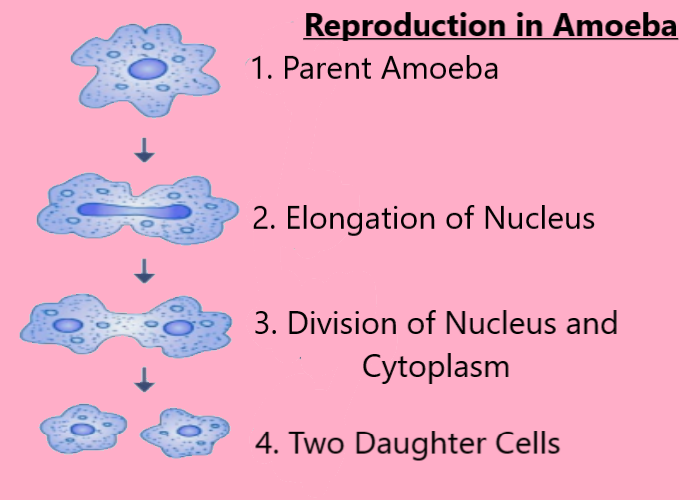Answer
394.5k+ views
Hint: Amoeba is a type of unicellular organism having the ability to change its shape, by extending and retracting pseudopods. The mature amoeba gets divided into two daughter cells and continues living.
Complete answer:
Amoeba is immortal because it does not undergo natural death. Amoeba is a unicellular organism that has the ability to change its shape. They are usually found in water bodies such as ponds, lakes and slow-moving rivers. Sometimes, these unicellular organisms can also make their way inside the human body and cause various illnesses. Amoeba get split by binary fission during which a parent cell produces two equally half cells and every daughter cell grows into an adult. There is no natural death in these organisms. There are no remains of parent body cells and parents cannot be said to have died. Parents start living as two daughter cells after binary fission. Amoeba reproduces by splitting in half asexually so that each daughter cell is the same as the parent. Running this process backward from the present, each existing amoeba is the same as it is in far time. In this regard amoeba is immortal. They cannot die but it gets bifurcated into daughter cells and makes other amoeba cells.

So, the correct answer is, 'True'.
Note:
-Even all single-celled organisms are immortal as they usually undergo mitosis to reproduce, in which the organism itself gets divided into two.
-Amoeba may be a unicellular organism, and a bit like bacteria, it reproduces through binary fission. -The cell divides into two equal-sized daughter cells after replicating its genetic material through mitotic division. In this method, two similar individuals are produced from one parent cell.
Complete answer:
Amoeba is immortal because it does not undergo natural death. Amoeba is a unicellular organism that has the ability to change its shape. They are usually found in water bodies such as ponds, lakes and slow-moving rivers. Sometimes, these unicellular organisms can also make their way inside the human body and cause various illnesses. Amoeba get split by binary fission during which a parent cell produces two equally half cells and every daughter cell grows into an adult. There is no natural death in these organisms. There are no remains of parent body cells and parents cannot be said to have died. Parents start living as two daughter cells after binary fission. Amoeba reproduces by splitting in half asexually so that each daughter cell is the same as the parent. Running this process backward from the present, each existing amoeba is the same as it is in far time. In this regard amoeba is immortal. They cannot die but it gets bifurcated into daughter cells and makes other amoeba cells.

So, the correct answer is, 'True'.
Note:
-Even all single-celled organisms are immortal as they usually undergo mitosis to reproduce, in which the organism itself gets divided into two.
-Amoeba may be a unicellular organism, and a bit like bacteria, it reproduces through binary fission. -The cell divides into two equal-sized daughter cells after replicating its genetic material through mitotic division. In this method, two similar individuals are produced from one parent cell.
Recently Updated Pages
Basicity of sulphurous acid and sulphuric acid are

What is the stopping potential when the metal with class 12 physics JEE_Main

The momentum of a photon is 2 times 10 16gm cmsec Its class 12 physics JEE_Main

Using the following information to help you answer class 12 chemistry CBSE

Which of the following would not be a valid reason class 11 biology CBSE

Why should electric field lines never cross each other class 12 physics CBSE

Trending doubts
Difference between Prokaryotic cell and Eukaryotic class 11 biology CBSE

Difference Between Plant Cell and Animal Cell

Select the word that is correctly spelled a Twelveth class 10 english CBSE

Fill the blanks with the suitable prepositions 1 The class 9 english CBSE

What is the z value for a 90 95 and 99 percent confidence class 11 maths CBSE

Give 10 examples for herbs , shrubs , climbers , creepers

What organs are located on the left side of your body class 11 biology CBSE

What is BLO What is the full form of BLO class 8 social science CBSE

Change the following sentences into negative and interrogative class 10 english CBSE



